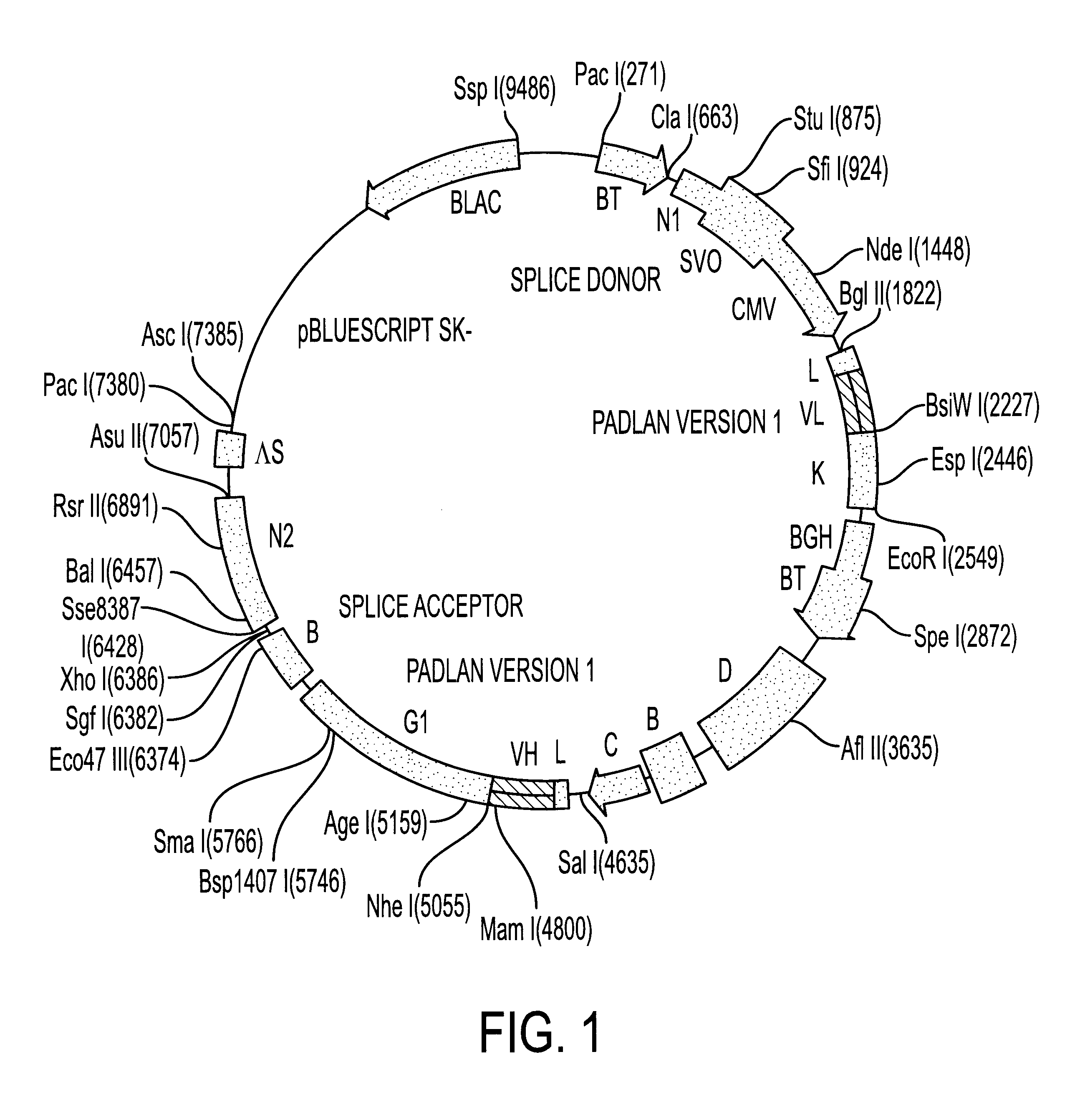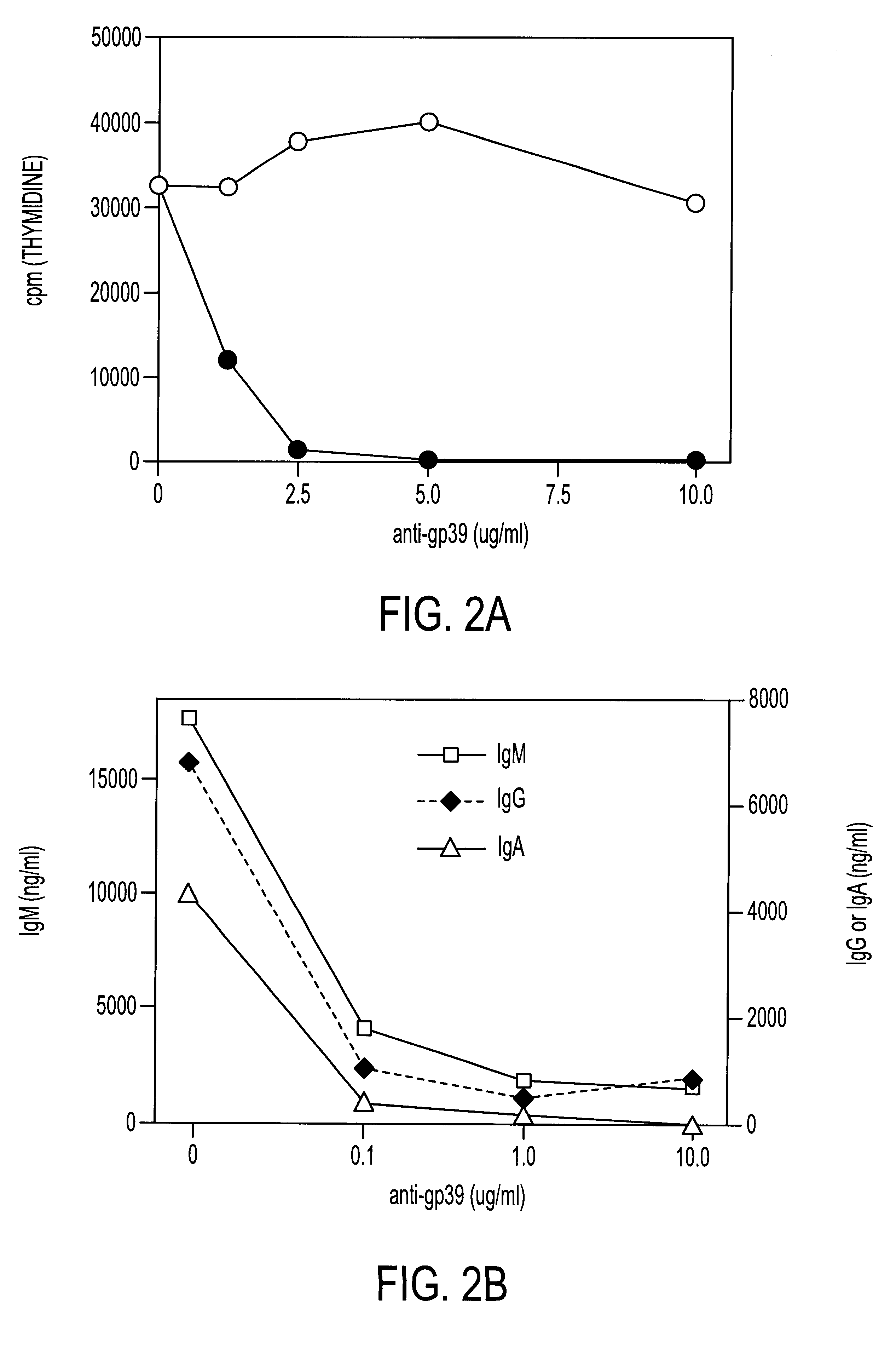Methods of treating autoimmune diseases with gp39-specific antibodies
a technology of gp39 and autoimmune diseases, applied in the direction of peptide/protein ingredients, dispersion delivery, fusion polypeptides, etc., can solve the problems of reducing the antibody response, disadvantage in some respects, and reducing the anti-plp antibody response, so as to improve the half-life and reduce the binding of the fc receptor
- Summary
- Abstract
- Description
- Claims
- Application Information
AI Technical Summary
Benefits of technology
Problems solved by technology
Method used
Image
Examples
example 2
T Cell-dependent B Cell Proliferation and Differentiation (Ig Production) is Blocked by Anti-gp39
A number of studies have provided evidence that signals delivered through CD40 by its ligand, gp39, induce B cell activation, proliferation, differentiation, and isotype switching. To determine if the anti-gp39 24-31 mAb blocked gp39 function, B cells were cultured with a soluble fusion protein of gp39 (gp39-CD8) in the presence or absence of 24-31, and the B cell proliferative response was assessed by .sup.3 H-thymidine incorporation. The results, shown in FIG. 2A, demonstrate that gp39-CD8 induced vigorous proliferation of B cells. The presence of anti-gp39 24-31 mAb completely ablated B cell proliferation induced by gp39-CD8 at concentrations as low as 2.5 .mu.g / ml. To determine whether 24-31 interfered with T cell-induced B cell differentiation, B cells were co-cultured with anti-CD3 activated T cells in the presence or absence of 24-31. Polyclonal IgM, IgG, and IgA production was as...
example 3
Anti-gp39 Blocks in vivo Tetanus Toxoid Specific Antibody Production in SCID Mice Reconstituted with Human PBL
Numerous studies have established that the human immune system can be studied in vivo under experimental conditions through the use of severe combined immunodeficiency (scid) mice engrafted with human peripheral blood lymphocytes (hu-PBL-scid mice) (Mosler et al, Nature, 335:256 (1988); McCune et al, Science, 241:1632 (1988). Long-term chimerism is achieved in scid mice by injection with human PBL, and antigen-specific secondary antibody responses are detected in hu-PBL-scid mice challenged in vivo with antigen (Carlsson et al, J. Immunol., 148:1065 (1992); Duchosal et al, Cell Immunol., 139:468 (1992)). This system was exploited to evaluate the immunosuppressive effects of in vivo anti-gp39 administration on the immune responses elicited by human T and B cells.
Experiments, the results of which are contained in FIG. 2B, demonstrated that blockade of gp39 function by 24-31 in...
example 4
Anti-gp39 Treatment does not Inhibit the Antigen-specific T Cell Proliferative Response of hu-PBL-scid Spleen Cells
To determine whether treatment of hu-PBL-scid mice with anti-gp39 altered the responsiveness of antigen-specific T cells in vivo, the proliferative response of spleen cells from hu-PBL-scid mice immunized with TT and treated with 24-31 was assessed in vitro. Spleen cells from control or anti-gp39 treated hu-PBL-scid mice were cultured with TT or medium alone, and the proliferative response was assessed by .sup.3 H-thymidine incorporation after 6 days. Table 5 summarizes the results of one such experiment. Hu-PBL-scid mice treated with anti-gp39 responded similarly to in vitro stimulation with TT as did hu-PBL-scid mice which were untreated (5 / 10 vs. 3 / 10 responding mice). Experiments using NOD / LtSz-scid / scid mice as recipients yielded similar results, although anti-TT antibodies were undetectable in these mice (data not shown). These data demonstrate that treatment with...
PUM
| Property | Measurement | Unit |
|---|---|---|
| concentrations | aaaaa | aaaaa |
| pH | aaaaa | aaaaa |
| temperature | aaaaa | aaaaa |
Abstract
Description
Claims
Application Information
 Login to View More
Login to View More - R&D
- Intellectual Property
- Life Sciences
- Materials
- Tech Scout
- Unparalleled Data Quality
- Higher Quality Content
- 60% Fewer Hallucinations
Browse by: Latest US Patents, China's latest patents, Technical Efficacy Thesaurus, Application Domain, Technology Topic, Popular Technical Reports.
© 2025 PatSnap. All rights reserved.Legal|Privacy policy|Modern Slavery Act Transparency Statement|Sitemap|About US| Contact US: help@patsnap.com



